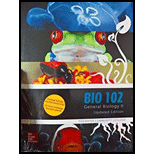
BIO 102 General Biology II Updated Edition (Tidewater Community College)
3rd Edition
ISBN: 9781259614064
Author: Tidewater Community College
Publisher: MCG CUSTOM
expand_more
expand_more
format_list_bulleted
Concept explainers
Question
Chapter 29.3, Problem 1MC
Summary Introduction
To determine:
The organization and function of bone tissue and cartilage.
Concept introduction:
Bones are a type of tissue where the cells are inside an extremely hard substance made of calcium, phosphorus and oxygen elements and of some other minerals in little amount. They form majority of the skeleton. They are hard form of connective tissues. Cartilage is also a connective tissue. It is not fully rigid and is therefore somewhat flexible in nature. It is found in those parts of the body where there is a need of some flexibility. It is found in the organs like nose, ears, knee and some other organs.
Expert Solution & Answer
Want to see the full answer?
Check out a sample textbook solution
Students have asked these similar questions
Please draw in the missing answer, thank you
Please fill in all blank questions, Thank you
please fill in missing parts , thank you
Chapter 29 Solutions
BIO 102 General Biology II Updated Edition (Tidewater Community College)
Ch. 29.1 - How do the skeletal and muscular systems interact?Ch. 29.1 - Prob. 2MCCh. 29.2 - What are the components of the axial and...Ch. 29.2 - Prob. 2MCCh. 29.3 - Prob. 1MCCh. 29.3 - What are the differences between spongy bone and...Ch. 29.3 - Prob. 3MCCh. 29.3 - Prob. 4MCCh. 29.3 - Prob. 5MCCh. 29.4 - Prob. 1MC
Ch. 29.4 - Prob. 2MCCh. 29.4 - Prob. 3MCCh. 29.5 - Prob. 1MCCh. 29.5 - Prob. 2MCCh. 29.6 - Prob. 1MCCh. 29.6 - Prob. 2MCCh. 29.6 - Prob. 3MCCh. 29.7 - Prob. 1MCCh. 29.7 - Prob. 2MCCh. 29 - The axial skeleton is to the appendicular skeleton...Ch. 29 - Prob. 2MCQCh. 29 - Prob. 3MCQCh. 29 - Prob. 4MCQCh. 29 - Prob. 5MCQCh. 29 - Distinguish among a hydrostatic skeleton, an...Ch. 29 - Prob. 2WIOCh. 29 - Use the Internet to research bone marrow...Ch. 29 - Prob. 4WIOCh. 29 - Design an experiment to test whether changes in...Ch. 29 - Prob. 6WIOCh. 29 - Describe four muscle proteins and their functions.Ch. 29 - Prob. 8WIOCh. 29 - Prob. 9WIOCh. 29 - Write the sequence of events that leads to a...Ch. 29 - Prob. 11WIOCh. 29 - 2. How do bones help maintain blood calcium...Ch. 29 - 3. Add exercise to the concept map in at least...Ch. 29 - Prob. 3PIT
Knowledge Booster
Learn more about
Need a deep-dive on the concept behind this application? Look no further. Learn more about this topic, biology and related others by exploring similar questions and additional content below.Similar questions
- please draw in the answers, thank youarrow_forwarda. On this first grid, assume that the DNA and RNA templates are read left to right. DNA DNA mRNA codon tRNA anticodon polypeptide _strand strand C с A T G A U G C A TRP b. Now do this AGAIN assuming that the DNA and RNA templates are read right to left. DNA DNA strand strand C mRNA codon tRNA anticodon polypeptide 0 A T G A U G с A TRParrow_forwardplease answer all question below with the following answer choice, thank you!arrow_forward
- please draw in the answeres, thank youarrow_forwardA) What is being shown here?B) What is indicated by the RED arrow?C) What is indicated by the BLUE arrow?arrow_forwardPlease identify the curve shown below. What does this curve represent? Please identify A, B, C, D, and E (the orange oval). What is occurring in these regions?arrow_forward
- Please identify the test shown here. 1) What is the test? 2) What does the test indicate? How is it performed? What is CX? 3) Why might the test be performed in a clinical setting? GEN CZ CX CPZ PTZ CACarrow_forwardDetermine how much ATP would a cell produce when using fermentation of a 50 mM glucose solution?arrow_forwardDetermine how much ATP would a cell produce when using aerobic respiration of a 7 mM glucose solution?arrow_forward
- Determine how much ATP would a cell produce when using aerobic respiration to degrade one small protein molecule into 12 molecules of malic acid, how many ATP would that cell make? Malic acid is an intermediate in the Krebs cycle. Assume there is no other carbon source and no acetyl-CoA.arrow_forwardIdentify each of the major endocrine glandsarrow_forwardCome up with a few questions and answers for umbrella species, keystone species, redunant species, and aquatic keystone speciesarrow_forward
arrow_back_ios
SEE MORE QUESTIONS
arrow_forward_ios
Recommended textbooks for you
 Human Biology (MindTap Course List)BiologyISBN:9781305112100Author:Cecie Starr, Beverly McMillanPublisher:Cengage Learning
Human Biology (MindTap Course List)BiologyISBN:9781305112100Author:Cecie Starr, Beverly McMillanPublisher:Cengage Learning Human Physiology: From Cells to Systems (MindTap ...BiologyISBN:9781285866932Author:Lauralee SherwoodPublisher:Cengage Learning
Human Physiology: From Cells to Systems (MindTap ...BiologyISBN:9781285866932Author:Lauralee SherwoodPublisher:Cengage Learning Principles Of Radiographic Imaging: An Art And A ...Health & NutritionISBN:9781337711067Author:Richard R. Carlton, Arlene M. Adler, Vesna BalacPublisher:Cengage Learning
Principles Of Radiographic Imaging: An Art And A ...Health & NutritionISBN:9781337711067Author:Richard R. Carlton, Arlene M. Adler, Vesna BalacPublisher:Cengage Learning Medical Terminology for Health Professions, Spira...Health & NutritionISBN:9781305634350Author:Ann Ehrlich, Carol L. Schroeder, Laura Ehrlich, Katrina A. SchroederPublisher:Cengage Learning
Medical Terminology for Health Professions, Spira...Health & NutritionISBN:9781305634350Author:Ann Ehrlich, Carol L. Schroeder, Laura Ehrlich, Katrina A. SchroederPublisher:Cengage Learning

Human Biology (MindTap Course List)
Biology
ISBN:9781305112100
Author:Cecie Starr, Beverly McMillan
Publisher:Cengage Learning

Human Physiology: From Cells to Systems (MindTap ...
Biology
ISBN:9781285866932
Author:Lauralee Sherwood
Publisher:Cengage Learning

Principles Of Radiographic Imaging: An Art And A ...
Health & Nutrition
ISBN:9781337711067
Author:Richard R. Carlton, Arlene M. Adler, Vesna Balac
Publisher:Cengage Learning

Medical Terminology for Health Professions, Spira...
Health & Nutrition
ISBN:9781305634350
Author:Ann Ehrlich, Carol L. Schroeder, Laura Ehrlich, Katrina A. Schroeder
Publisher:Cengage Learning


Types of Human Body Tissue; Author: MooMooMath and Science;https://www.youtube.com/watch?v=O0ZvbPak4ck;License: Standard YouTube License, CC-BY